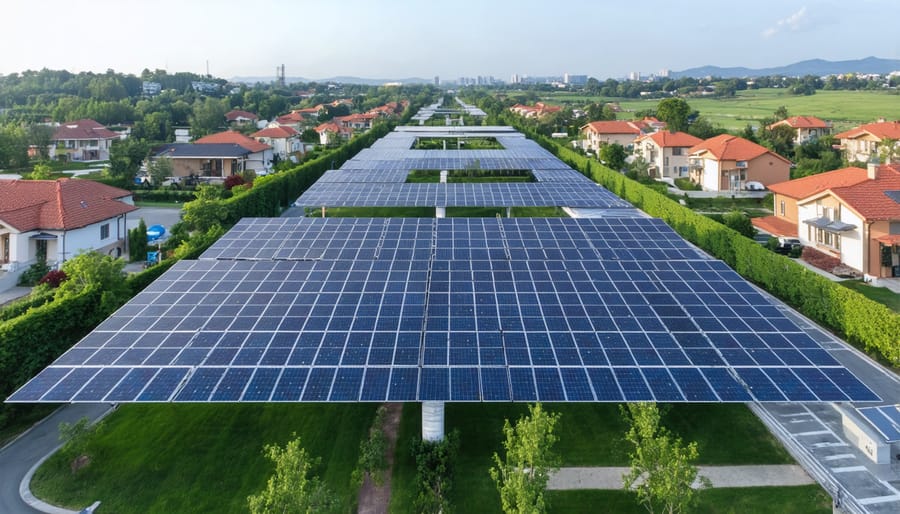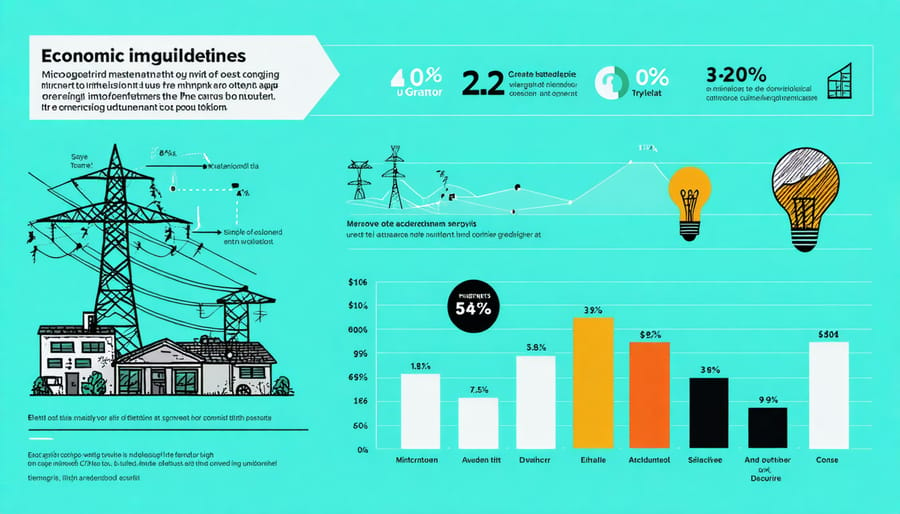Microgrids: The Power Behind Europe’s Solar Energy Revolution

Microgrids represent a revolutionary shift in power distribution, offering unprecedented control over energy resources while enhancing reliability and sustainability. These localized energy systems enable communities and organizations to operate independently from the main power grid, providing crucial resilience during outages and natural disasters. By integrating renewable energy sources, advanced storage solutions, and intelligent control systems, microgrids deliver both environmental and economic benefits that transform how we generate, distribute, and consume electricity.
In an era where energy security and climate action take center stage, microgrids emerge as a powerful solution for European businesses and communities seeking energy independence. These systems not only reduce carbon footprints but also offer substantial cost savings through optimized energy management and reduced transmission losses. Whether powering industrial facilities, hospital complexes, or entire neighborhoods, microgrids provide the flexibility and reliability needed to meet evolving energy demands while supporting Europe’s transition to a sustainable energy future.
Energy Independence and Security

Grid Reliability in Local Communities
Microgrids significantly enhance local power reliability by providing dedicated backup power systems that operate independently from the main grid. This capability proves invaluable during extreme weather events, equipment failures, or planned maintenance periods that might otherwise result in widespread outages. Communities implementing energy independence through microgrids experience notably fewer disruptions to essential services and business operations.
The sophisticated control systems within microgrids automatically detect grid disturbances and seamlessly transition to island mode, ensuring continuous power supply to critical facilities like hospitals, data centers, and emergency services. This rapid response capability typically reduces downtime from hours to mere seconds, providing crucial reliability for modern digital infrastructure.
In European communities, microgrids have demonstrated impressive reliability metrics, with some systems achieving up to 99.9% uptime. By incorporating local generation and storage capabilities, these systems create a robust power infrastructure that’s less vulnerable to cascading failures common in traditional grid systems. This enhanced reliability translates into tangible economic benefits, with businesses experiencing fewer production losses and communities maintaining essential services during grid disruptions.
Emergency Response and Critical Infrastructure
Microgrids play a crucial role in maintaining essential services during emergencies and protecting critical infrastructure. Hospitals, emergency response centers, and data facilities rely on microgrids to ensure uninterrupted power supply when the main grid fails. These systems provide immediate backup power, enabling healthcare providers to continue life-saving procedures and emergency services to maintain operations during natural disasters or grid outages.
For example, several European hospitals have implemented microgrid solutions, combining solar power with battery storage to achieve remarkable grid stability improvements and resilience. During the 2021 winter storms, a hospital in northern France maintained full operations for 72 hours using its microgrid system while surrounding areas experienced extended blackouts.
Military installations and governmental facilities across Europe increasingly adopt microgrids to enhance security and operational continuity. These systems protect sensitive operations from cyber threats and physical grid disruptions while supporting broader community resilience during crisis situations. The ability to operate independently from the main grid ensures that essential services remain available when they’re needed most.
Economic Advantages of Solar Microgrids

Reduced Energy Costs
Microgrids excel at optimising energy consumption patterns, leading to substantial cost reductions for both businesses and communities. Through intelligent load management and peak shaving capabilities, these systems can significantly decrease energy expenses by up to 25-30% in many European installations.
The cost-saving potential stems from multiple factors. Firstly, microgrids enable users to generate and store their own energy, reducing dependency on grid electricity during peak pricing periods. This ability to switch between self-generated and grid power based on real-time pricing creates impressive savings opportunities.
Additionally, microgrids enhance energy efficiency through advanced monitoring and control systems. These systems automatically optimise energy distribution, reducing waste and maximising the use of renewable sources when they’re most abundant. For industrial facilities, this can translate to annual savings of €50,000-€200,000, depending on the facility size and energy consumption patterns.
The long-term financial benefits extend beyond direct energy costs. Microgrids reduce transmission losses, minimize demand charges, and provide opportunities for participation in energy markets through demand response programmes. When combined with regular maintenance and system optimization, these savings continue to accumulate over the system’s lifetime, often resulting in complete return on investment within 5-7 years.
Revenue Generation Opportunities
Microgrids offer compelling revenue generation opportunities through innovative energy trading and grid services. Operators can participate in demand response programmes, selling excess energy back to the main grid during peak demand periods when electricity prices are highest. This capability allows microgrid owners to transform from pure consumers to active market participants, creating new income streams.
Through advanced energy management systems, microgrids can provide valuable ancillary services to the main grid, including frequency regulation and voltage support. These services are increasingly valued by grid operators, who often offer financial incentives for reliable support providers. In many European markets, microgrid operators can also engage in peer-to-peer energy trading, allowing them to sell surplus power directly to neighbouring facilities or communities.
The revenue potential extends to capacity markets, where microgrid operators can bid their available capacity and receive payments for being ready to support grid stability. Additionally, some regions offer specific incentives for microgrids that incorporate renewable energy sources, creating multiple revenue streams through feed-in tariffs and green certificates.
For businesses and industries, these revenue opportunities can significantly offset initial investment costs while contributing to a more resilient and sustainable energy infrastructure.
Environmental Impact
Carbon Footprint Reduction
Microgrids significantly reduce carbon emissions through their integration of renewable energy sources and optimised energy management. Studies across European installations demonstrate that microgrids can lower carbon emissions by 20-50% compared to traditional grid systems. This reduction stems from multiple factors, including decreased transmission losses, efficient load management, and the prioritisation of clean energy sources.
A typical commercial microgrid installation in Europe can offset approximately 500-1000 tonnes of CO2 emissions annually, equivalent to removing 100-200 cars from the road. The environmental impact becomes even more substantial when considering industrial applications, where microgrids can reduce facility emissions by up to 60% through strategic energy distribution and storage.
Moreover, microgrids enable better integration of renewable energy sources, ensuring that clean energy is utilised efficiently and excess production is properly stored rather than wasted. This optimisation leads to a cascading effect of environmental benefits, including reduced air pollution and decreased strain on natural resources.
Renewable Energy Integration
Microgrids excel at incorporating renewable energy sources like solar panels and wind turbines into local power systems. Their advanced control systems seamlessly manage the variable nature of renewable generation, ensuring stable power supply even when sunlight or wind conditions fluctuate. This integration capability allows communities and businesses to maximise their renewable energy usage while maintaining reliable power delivery.
The flexible architecture of microgrids enables gradual expansion of renewable capacity, making the transition to clean energy both practical and cost-effective. Modern microgrids can intelligently balance multiple renewable sources, energy storage systems, and traditional power sources, optimising energy flow based on real-time conditions and demand patterns.
For European enterprises pursuing sustainability goals, microgrids serve as a crucial enabling technology. They provide the infrastructure needed to increase renewable energy adoption while ensuring power quality and system stability. This makes microgrids particularly valuable in regions with ambitious clean energy targets and strong environmental regulations.
Smart Grid Integration
Advanced Energy Management
Microgrids excel in advanced energy management through sophisticated smart grid management systems that optimize power distribution and consumption in real-time. These intelligent control systems continuously monitor energy flow, automatically adjusting to demand fluctuations and available renewable resources.
Using advanced algorithms, microgrids can predict energy needs based on historical usage patterns, weather forecasts, and time-of-day consumption trends. This predictive capability enables precise load balancing and efficient resource allocation, ensuring optimal performance while minimizing waste.
The system’s automation features enable seamless switching between different power sources, prioritizing renewable energy when available and seamlessly transitioning to stored or grid power when necessary. This dynamic response capability maintains consistent power quality while maximizing the use of clean energy sources.
For European facilities, these management systems offer customizable controls that adapt to specific operational needs, local energy pricing, and regional grid requirements. Facility managers can access detailed analytics and performance metrics through user-friendly interfaces, enabling data-driven decisions for further optimization and cost reduction.

Future-Proofing Energy Infrastructure
Microgrids excel at adapting to emerging energy technologies, making them an ideal foundation for future-proof energy infrastructure. Their modular design allows for seamless integration of new renewable energy sources, storage solutions, and smart management systems as they become available. This scalability ensures that initial investments maintain their value while accommodating growing energy demands and technological advancements.
European businesses and communities particularly benefit from this adaptability as the continent leads in renewable energy innovation. Microgrids can easily incorporate upcoming technologies like advanced battery storage, hydrogen fuel cells, and enhanced solar panels without requiring complete system overhauls. This flexibility extends to smart grid capabilities, enabling integration with emerging energy management platforms and IoT devices.
The infrastructure’s scalable nature also supports gradual expansion, allowing organisations to start with essential components and grow their system according to needs and budget. This approach proves especially valuable for businesses planning long-term sustainability strategies, as they can systematically upgrade their energy infrastructure while maintaining operational continuity and maximising return on investment.
Microgrids represent a transformative solution for Europe’s energy landscape, offering a powerful combination of reliability, sustainability, and economic benefits. By providing enhanced energy security through localised power generation and storage, microgrids ensure continuous operations during grid disruptions while significantly reducing carbon emissions. The integration of renewable energy sources, particularly solar power, makes microgrids an essential tool in achieving Europe’s ambitious climate goals.
The financial advantages are equally compelling, with reduced energy costs, optimised consumption patterns, and potential revenue streams through energy trading. For businesses and communities, microgrids offer unprecedented control over their energy destiny, enabling smart management of resources and fostering energy independence.
As we move towards a more sustainable future, the implementation of microgrids becomes not just an option but a necessity. Whether you’re a homeowner, business leader, or community planner, now is the time to explore microgrid solutions. By embracing this innovative technology, you can contribute to a more resilient and sustainable energy infrastructure while securing long-term economic benefits. Take the first step towards energy autonomy by consulting with experienced providers who can guide you through the implementation process.
Leave a Reply